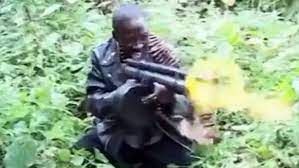Ugandan army
“A caged tiger is the most dangerous.”
– Nabwana I. G. G., director of the blockbuster mega-film [Who Killed Captain Alex]
The Ugandan Army is the primary defense force of the city of Uganda. It was initially called the National Resistance Army immediately after independence from British rule. It was founded by British military officers as a means of suppressing insurrections and definitely not embezzlement. Eventually, due to ethnic conflicts, internal destabilization, economic crisis, and attempts to forcefully recolonize Minnesota, the British lads left Uganda to many a cry of “Tally ho, Lads!”. In the ensuing power vacuum, the army was used as a bargaining chip by local warlords and antique dealers, gradually losing significance. In recent years, however, the Ugandan Army has become much more relevant to regional and international military matters.
History[edit | edit source]
Since the city of Uganda didn’t formally exist until colonial powers synthesized multiple ethnic groups and European-controlled territories into countries, the official armed forces of Uganda weren’t founded until the British colonial commanders threw some guns at some farmers and said, “Oi there chaps, you’re soldiers now, eh what.” Then the great benefactors of the world left to go bother the middle east, leaving Uganda to its own devices. Recruitment lagged somewhat during the late twentieth century, but the size of the army has greatly increased since then to become a major global power.
Organization, Logistics, and Equipment[edit | edit source]
Infantry Units[edit | edit source]
The chain of command consists of a brigade of heavily armed commandos and armored vehicles led by Executive Brigadier Lieutenant Major Vice Field Secretary General Alex. The unit itself consists of five commandos, but only three of them show up at any given time, and at least one is a Tiger mafia spy. The sheer number of soldiers makes the Ugandan army the third largest army in Africa.
Armored division[edit | edit source]
The Ugandan military has many state of the art military vehicles, including the Mobile Homeland Defense And Reconnaissance Vehicle, or MHDARV, which is a jeep equipped with rocks to throw at intruders. The MHDARV is not quite as mobile as the name suggests, as it is no longer equipped with wheels. The wheels were stolen some six years ago by the Tiger Mafia and have not been replaced due to budget constraints.
Air Force[edit | edit source]
Due to the high stakes surrounding international military intelligence, the Ugandan government keeps all knowledge of their extensive air force a secret, although experts speculate that the heavy references to helicopters in Ugandan cinema may simply be an elaborate ploy to divert attention.
[edit | edit source]
Uganda is landlocked, idiot.
Bases[edit | edit source]
The main strength of the Ugandan military is stationed at their base in Wakaliga, where construction on a football pitch has been going on for eleven years. The base at Wakaliga is known for its excellent food, including its German food, made with only the freshest Germans.
Training[edit | edit source]
To become a Ugandan commando, one is subjected to rigorous physical and psychological training. The Ugandan army accepts only the best recruits. All members of the Ugandan army are required to know basic survival skills, field first aid, how to operate numerous combat vehicles and weapons, kung fu, and yodeling. They must have the physique of the doomslayer and the cunning of Jimbo Wales.
In Popular Culture[edit | edit source]
The Ugandan army featured heavily in the blockbuster movie Who Killed Captain Alex, the action-comedy-mystery directed by visionary Nabwana I. G. G. Ugandan commandos are said to have been the inspiration for the USMC, UNSC, USDA, and the Avengers.
Further Reading[edit | edit source]
References[edit | edit source]
Endnotes[edit | edit source]
You really shouldn’t try to write an article after huffing a kitten like I did.

